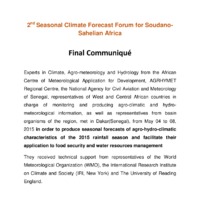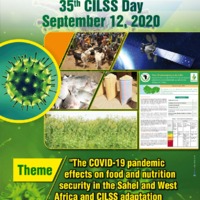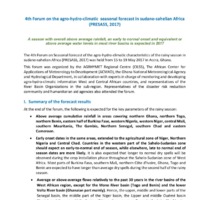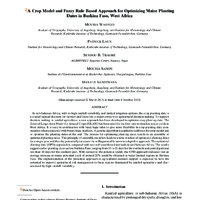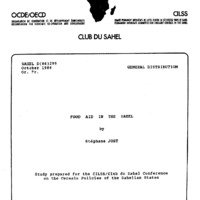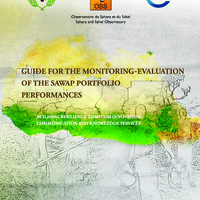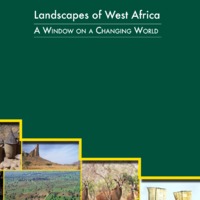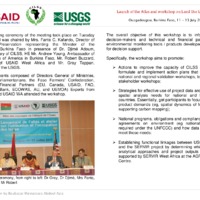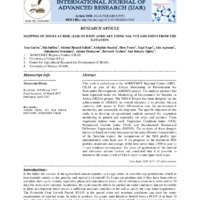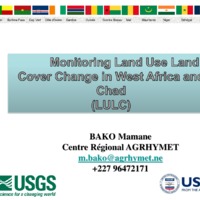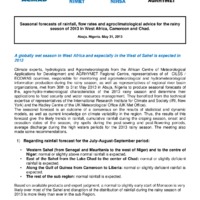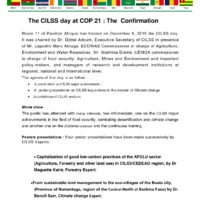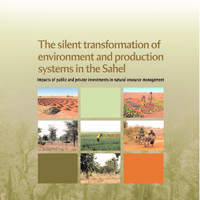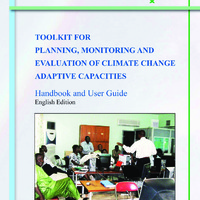Recherche
25 items
2nd Seasonal Climate Forecast Forum for Soudano- Sahelian Africa: Final Communiqué
Experts in Climate, Agro-meteorology and Hydrology from the African Centre of Meteorological Application for Development, AGRHYMET Regional Centre, the National Agency for Civil Aviation and Meteorology of Senegal, representatives of West and Central African countries in charge of monitoring and producing agro-climatic and hydrometeorological information, as well as representatives from basin organisms of the region, met in Dakar(Senegal), from May 04 to 08,
2015 in order to produce seasonal forecasts of agro-hydro-climatic characteristics of the 2015 rainfall season and facilitate their application to food security and water resources management
35th CILSS Day September 12, 2020
"The COVID-19 pandemic effects on food and nutrition security in the sahel and west Africa and CILSS adaptation efforts for information production"
4th Forum on the agro-hydro-climatic seasonal forecast in sudano-sahelian Africa (PRESASS, 2017)
A season with overall above average rainfall, an early to normal onset and equivalent or above average water levels in most river basins is expected in 2017.
A Crop Model and Fuzzy Rule Based Approach for Optimizing Maize Planting Dates in Burkina Faso, West Africa
In sub-Saharan Africa, with its high rainfall variability and limited irrigation options, the crop planting date is a crucial tactical decision for farmers and therefore a major concern in agricultural decision making.
A successful experimentto promote peaceful livestockmobility as a cornerstone of production and marketing systems in West Africa
The N’Djamena symposium in the Republic of Chad (May 2013) and the Nouakchott
declaration in the Islamic Republic of Mauritania (October 2013) have given renewed
interest to the livestock sector in view of its significant contribution to people’s incomes
and food security. The PREDIP (Projet régional de dialogue et d’investissement pour
le pastoralisme et la transhumance transfrontalière au Sahel et dans les pays côtiers
de l’Afrique de l’Ouest - Regional Dialogue and Investment Project on Pastoralism and
Transhumance in the Sahel and Coastal West Africa (PREDIP), along with several other
regional initiatives (PRAPS, PEPISAO, etc.) was then implemented to promote and
enhance mobile livestock farming. Implemented between 2018 and 2024, PREDIP covered eight (08) countries, including five (05) coastal countries (Benin, Côte d’Ivoire, Ghana, Nigeria, and Togo) and three (03) Sahelian countries (Burkina Faso, Mali and Niger), with the main approach being to target cross-border areas between the south of Sahelian countries and the north of coastal countries. These areas, which are known to have a high concentration of animals, are also known to be conflict-ridden due to the exploitation of pastoral resources shared between users. Over the five (05) years of its implementation, PREDIP has provided innovative solutions to the unique challenges of managing pastoral resources, transhumance and interactions between pastoralists and farmers in Sahelian and coastal areas. Whether in terms of improving information systems, sector governance, setting up agro-pastoral infrastructure and facilities or promoting animal health, PREDIP has made significant gains and learnt from its practices. This summary note presents the Project’s main milestones, its achievements, its positive impact, as well as the innovations and best practices that have emerged from its implementation. In view of the challenges that have been met and the results that have been achieved, this brochure also bears witness to the unwavering commitment of all those involved in the successes achieved by PREDIP.
Ensuring peaceful livestock mobility
Mobile livestock production in the Sahel and West Africa is a way of life and a form of adaptation and resilience developed over thousands of years by pastoralists and agro-pastoralists to cope with the effects of desertification and climate change, and to make the best use of the vast expanses of arid and semi-arid regions. This livestock farming system makes it possible to seek complementarities with the agro-ecological zones of the southern savannah regions through the use of pasture and water. In this way, livestock farming helps to provide substantial income for the local population and ensure food security. The N’Djamena symposium in the Republic of Chad (May 2013) and the Nouakchott declaration in the Islamic Republic of Mauritania (October 2013) gave renewed interest to the livestock sector with the implementation of several regional initiatives such as PRAPS, PREDIP, PEPISAO financed respectively by the World Bank, the European Union and the Agence Française de Développement and coordinated by CILSS as well as others such as PACBAO, MOPSS, etc.
Ensuring peaceful livestock mobility
Livestock farming plays a central role in the national and regional economies of West
Africa. It accounts for up to 10-15% of the GDP of the Sahelian states1 and contributes
to the local economies of the host areas of transhumant livestock farmers2. It is a major
source of income and employment throughout the sector, providing up to 99% of the red
meat consumed in the sub-region. Pastoral and agropastoral livestock farming systems,
based on the mobility of livestock, are still largely dominant in the sub-region. Several
regional pastoral development initiatives, such as the Projet régional d’appui au
pastoralisme au Sahel or Sahel Regional Pastoralism Support Project (PRAPS), the
Projet régional de dialogue et d’investissement pour le pastoralisme et la transhumance au Sahel et dans les pays côtiers de l’Afrique de l’Ouest or Regional dialogue and Investment Project for Pastoralism and Transhumance in the Sahel and Coastal Countries of West Africa (PREDIP) and the Projet Elevages et pastoralisme intégrés et sécurisés en Afrique de l’Ouest or Integrated and Secure Livestock Production systems and Pastoralism in West Africa Project (PEPISAO), have been developed and implemented by the Permanent Inter-state Committee for Drought Control in the Sahel (CILSS).
Evaluation of the regulatory framework for pastoralism and cross border transhumance in West Africa and the Sahel
i) The Economic Community of West African States (ECOWAS) is a pioneer in establishing regulations for the exercise of cross-border transhumance, a somewhat controversial livestock production system in relation to its economic, social and environmental impacts, and the conflicts of access to natural resources that are sometimes associated with it.
ii) Since 1998, ECOWAS has been experimenting with a set of legal and technical instruments to provide a framework for the exercise of this multi-functional credited activity, which makes it a powerful means of strengthening the resilience of populations in general, and pastoralist and herder households in particular, on the one hand, and promoting social and regional integration in West Africa, on the other.
Landscapes of west africa : a window on changing world
Beyond raising awareness, the atlas also aims to incite action to protect the environment of West Africa and the Sahelian region. We therefore invite everyone — scientists, students, researchers, teachers, planners, managers of development or research projects, local, national and regional decision-makers, donors, members of civil society organizations, and visitors to the region — to make the most of this work.
Mapping of Zones At Risk (ZAR) in west Africa by using NGI, VCI and SNDVI from the E-statuib
This work is carried out at the AGRHYMET Regional Centre (ARC)-CILSS as part of the African Monitoring of Environment for Sustainable Development (AMESD) project. The analysis protocol has been improved under the Monitoring of Environment for Security in Africa (MESA) project. The MESA Project has been designed on the achievements of AMESD; its overall objective is to provide African countries with access to Earth Observation data for environmental monitoring and sustainable development. The specific objective of this study is to develop an operational analysis protocol for vegetation monitoring in general and especially for crops and pastures. Three vegetation indices were used: Vegetation Condition Index (VCI), Normalized Growth Index (NGI) and Standardized Normalized Difference Vegetation Index (SNDVI). The analysis of these drought indices is based on taking into account the agro-climatic characteristics of the Sahelian region, the comparison of the NGI profile (per administrative unit) from year X (in progress) to the maximum NGI profiles, minimum and average of the time series data (1998 to year x-1) and evidence convergence. Six years of application of the method and validation actions carried out concluded that it is possible to determine the zones at risk (ZAR) in order to anticipate food crises.
Niamey declaration of the 3rd CICC2024
For a holistic governance of the management of disaster risks caused by extreme climatic events in West Africa in the Sahel
Performance of similarity analysis in the estimation of forage yields in the Sahelian zone of Niger
The study aims to test the performance of similarity analysis in herbaceous fodder biomass estimate in the Nigerian pastoral zone, in a context of insecurity and precipitation spatiotemporal variability. It is carried out on the time series of NDVI decadal images of SPOT VEGETATION for the period from 2001 to 2012 and on fodder biomasses measured in situ during the same period. Similarity analysis compares NDVI seasonal patterns to detect similar years using three criteria: the RMSE (Root Mean squared error), the MAD (Mean absolute Deviation), and R². Exploratory statistical analyzes with bootstrap are carried out to better characterize the observations resulting from the simulation. Moreover, the analysis of the parametric and non-parametric correlations is carried out to evaluate the level of link between the simulated data and the real data. The t test and the Wilcoxon test are then carried out in order to compare the means of the actual biomasses with those obtained by the similarity analysis. At the local level, the results indicate that the R² is more efficient than the RMSE and the MAD which have almost the same performances. The results of the similarity calculated with R² can be used as a proxy to the herbaceous phytomass measured in situ, as there is no significant difference between the simulated mean and the mean measured at the 1% threshold. On the other hand, the results of the similarity calculated with the RMSE and the MAD are not exploitable. Parametric and nonparametric correlations are all significant at the 1% threshold. However, the R² are low and vary between 0.32 and 0.45. It therefore seems necessary to continue the research, as numerous studies have revealed very good links between certain indices like the FAPAR, the EVI and the LAI and the aerial phytomasse.
Products for capitalizing on experiences and acquired knowledge of PREDIP
CILSS has achieved significant results and a great deal of experience through the PREDIP implementation. A sample of eleven (11) major experiments and lessons learnt have been drawn up and documented using the “ongoing capitalisation» approach, with a view to building on these achievements for the benefit of stakeholders in the livestock and pastoralism sub-sector in the Sahel and West Africa. The experiments cover all the themes addressed by PREDIP (i.e., regional pastoral information service, dialogue and governance on cross-border transhumance, agro-pastoral infrastructures and facilities, animal health). Each of the fact sheets documenting these experiments includes a short summary giving the reader an overview of the content of the experiment and enabling him or her to extract the information he or she needs. In addition to these eleven (11) sheets, two (2) capitalisation notes have been produced. These experiments and capitalisation notes can be scaled up for greater value. They complement the existing body of knowledge on the promotion of the livestock sub-sector. For more detailed information, the reader is kindly invited to read the full report entitled: «Experience gained and lessons learnt from PREDIP implementation».
Products for capitalizing on experiences and acquired knowledge of PREDIP
Livestock farmers in West Africa and the Sahel lack access to sufficient information on seasonal weather forecasts, fodder resource availability, livestock market situation, and health and security situation. The aim of the Regional Pastoral Information Service
(SRIP), PREDIP project Component 1, is to improve farmers’ access to reliable technical information tailored to their needs, so that they can optimise their tactical and strategic herd management choices and reduce the risk of conflict with farmers. The information produced as part of the implementation of the SRIP reaches farmers via social networks, call centres and community radio stations. One of the SRIP’s experiments involved the production of interactive programmes by community radio stations. This note capitalises on the experience of radio broadcasts in the regions of Dosso and Maradi in Niger. The themes of the interactive programmes were chosen on the basis of the information needs identified amongst livestock farmers following a preliminary survey
carried out by AGHYMET CCR-AOS, the PREDIP technical focal points and the community radio coordinators. Broadcasts were made in the local languages of these regions. A total of 99 programmes were produced and broadcast by radio stations in 26 communes, including 14 in Dosso and 13 in Maradi. These programmes were broadcast 3,150 times, with an average of 200 editors per programme. Following the broadcasts, a field mission was carried out to assess the impact of the programmes. It turned out that
the broadcasts had made a significant contribution to the timely reception of information and to improving listeners’ knowledge. This has raised awareness, leading to better cohabitation between farmers and herders and calmer transhumance. The professionalism of the community radio stations, the support of the various partners and local authorities, the effective participation of farmers’ associations and the involvement of youth clubs played a key role in the success of these broadcasts. However, the lack of financial and material resources was one of the difficulties encountered by the radio stations. Farmers also complained about the short duration of the broadcasts. In view of these difficulties, partnerships with other radio stations,
extending the duration of broadcasts, and technical and financial support are solutions that have been adopted or are being considered to improve the success and sustainability of the broadcasts.
Special Bulletin of the 2024 Seasonal forecasts of the Agro-Hydro-Climate characteristics for the Sahelian and Sudanian zones of West Africa and the Sahel PRESASS 2024
The 2024 Edition of the PRESASS was organized from April 22 to 26, 2024 in Abuja, Nigeria, by AGRHYMET Regional Climate Center for West Africa and the Sahem (AGRHYMET RCC-WAS) of the CILSS, in collaboration with ACMAD, the National Meteorological and Hydrological Services (NMHSs), WMO and the West African River Basin Organizations.
.......Generally a wet rainy season is expected in 2024 over the Sahelian belt, with late to normal starting dates of the agricultural season in the Sahel-Central and early to normal s in the Sahel-West and East; late to normal ending dates of the agricultural season; short dry spells at the beginning of the season in the Sahel-West and medium to long dry spells in the Sahel-East and generally long dry spells towards the end of the season over the entire Sahelian belt; and above-average runoff in the main Sahelian river basins.......
The cilss day at cop 21 : the confirmation
Posters presentations : Four poster presentations have been made successively by CILSS Experts: Capitalization of good low-carbon practices of the AFOLU sector (Agriculture, Forestry and other land use) in CILSS/CEDEAO region, by Dr Maguette Kairé, Forestry Expert; From sustainable land management to the eco-villages of the Boala city, (Province of Namentega, region of the Central-North of Burkina Faso) by Dr. Benoît Sarr, Climate change Expert; CILSS platform in the field of climate change and sustainable land management, by Dr. Issaka Lona, climate change expert; Scaling of smart agriculture for food security in the Sahel, Dr. Edwige Botoni, Natural Resource Management Expert;
Toolking for planing, monotorin and evaluation of climate change adaptive capacities
Climate change is among the most serious threats confronting every person on the entire planet, and African populations are particularly vulnerable. All livelihoods suffer from the isolated or combined effects of many climate hazards that can negatively affect their productivity, and consequently food security and populations’ living conditions. Therefore, seeking to reduce the harmful effects of climate hazards relates directly to the fight against poverty. Reducing poverty and promoting human development depend in part on the reduction of greenhouse gas concentration in the atmosphere to prevent climate change (mitigation). But given that climate change is already happening and will continue to do so because of current and still-rising levels of carbon dioxide (CO2) in the atmosphere, it is also necessary to develop robust ways for natural and human systems to adjust in the face of future climate change effects (adaptation). Discussions on climate change now recognize that in addition to efforts to mitigate the phenomenon, strategies to enhance adaptation are a priority. This recognition has led to the unprecedented proliferation of many initiatives (projects, programs and policies) that relate climate change to development efforts. These initiatives, however, have so far hardly generated the expected outcomes. The disappointing results are due, in part, to the approaches and tools that were used to identify, plan, monitor and evaluate the initiatives. A study undertaken by the United Nations Economic Commission for Africa (Somda, 2010) on the shortcomings in the fields of monitoring and evaluation shows that these approaches are not sufficiently harmonized; they do not permit the drawing of consistent lessons that could improve the relevant formulation and implementation of new initiatives for climate change adaptation. This publication aims to resolve this issue by offering insights into harmonized approaches and tools for identifying, planning, monitoring and evaluating climate change adaptive capacities. It presents the theoretical approach and includes a practical users’ guide intended for development professionals, researchers and policy-makers. It contains a toolkit that harmoniously combines a number of existing approaches and tools for use at various intervention scales, and in this way defines a vision and a behavioural change strategy that are essential in the climate change adaptation process.
VALIDATION OF A HERBACEOUS BIOMASS ASSESSMENT MODEL FOR SAHELIAN RANGELANDS (BIOMASAH) IN NIGER
This study was carried out in the pastoral zone of Niger with the aim of validating outputs of the BIOMASAH model developed by the AGRHYMET Regional Centre (ARC) relative to real data collected over the 2001-2011 period by the Ministry Livestock and Animal Industries (MEIA) of Niger. We used parametric tests (t-tests) and nonparametric tests (Wilcoxon and sign tests) for mean comparisons. A correlation analysis was performed by calculating Pearson’s r, Spearman’s ρ, Kendall’s T and Hoeffding’s D correlation coefficients. The results showed that the BIOMASAH model generally overestimated biomass (983.17 vs. 591.17 kg/ha) with a highly significant difference relative to the field findings (P <.0001). Pearson’s r (0.15), Spearman’sρ (0.22) Kendall’s T (0.13) and Hoeffding’s D (0.1) correlation coefficients were low but highly significant (p <.0001). Grazing pressure and spatiotemporal variability of rainfall helped explain the noted differences.
